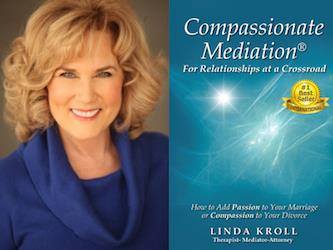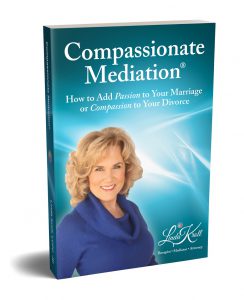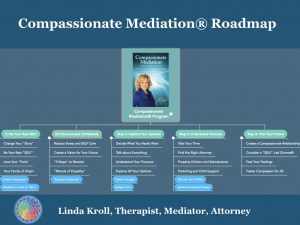SELF in Mediation
(from a Mediation Training in 1998)
My twenty-one year old daughter (who is now 40) recently called me at the end of her first year of her doctoral program in psychology to tell me she really didn’t want to be a psychologist. She wanted a profession in which there would be one right answer and not so many possibilities. Worried that she was going to switch to law school, I mentioned that even in law, you can argue two sides. And her response was, “Yes, but there are only two.” And I thought to myself, she should never go into mediation.
On some existential level, I think she was trying to make sense out of this world. And the more she was learning, the more confusing it all seemed. And I thought to myself, the more confusing it seemed, the more she is learning about the world, and it’s in the acceptance of that confusion, we have the freedom to choose our version of reality. Kind of like mediation.
Within the same week, I heard Robert Benjamin speak at the first annual Mediation Council dinner. In his speech on the search for truth, he said that too often mediators focus on the quest for the TRUTH, instead of emphasizing the QUEST itself.
And I tell my clients that I wish there were some formula we could plug in when you’ve been married X number of years and you have X number of children that you are entitled to, or responsible for, X amount of maintenance for X number of years and the property division will be according to some preordained plan.
Now I sound like my daughter.
Sometimes I wish there were one answer and we could plug the data into some kind of program and spew out THE ANSWER. Kind of like some fool proof recipe. Take these ingredients and you have this specific dish. Take those ingredients, you have another.
Or at least have a computer program – perhaps call it Mediation for Dummies, and input the facts of the case and within seconds download the memorandum of understanding.
Once we have helped our clients generate all their options, we could have some automatic printout of the course they should take, the decisions they should make. We would offer them THE ANSWER, THE TRUTH.
Robert Benjamin said that we can do a disservice to our clients if we try to “heal” them and convince them with logic to reach an amicable resolution when they are really feeling anger, sadness, frustration. He suggested we take them where they are and help them carve out a little bit of space where they can make decisions for themselves without other people in power telling them how to run their lives. We’re not seeking THE ANSWER, just AN answer that works for them within a myriad of possibilities from which they have the power to choose.
But who is making those choices? Is it us, as mediators? No, we are supposed to be neutral parties. Maybe at times we wish we could decide for them. Other times we may let them know what we think “if we had a vote.”
We might not tell our colleagues, but at times we might actually be directive and lead them towards our version of equity. But whether their understanding is organic with them or we play a role in the choices made, which parts of all of us are doing the choosing?
Which PARTS did I say? Yes, which parts?
I must digress slightly, or elucidate more clearly, depending on your point of view.
I have recently completed a two year training program(which I continued for another 17 years) with Richard Schwartz, a psychologist who introduced the theory of Internal Family Systems, which identifies one’s Self and Parts. To explain very briefly.
We all have a Self, with a capital “S”. And we all have different Parts that get activated, burdened, out of balance.
When we are in “Self” we are balanced, peaceful, calm, compassionate, open. When different parts are activated, we can blend with those parts and be angry, scared, frustrated, opinionated, know-it-all, patronizing, insecure, impatient, sarcastic, defeated …. or any number of feelings or emotions that keep us off center and out of Self.
Dick Schwartz also has posited that we have three different types of parts: the Managers, the Firefighters and the Exiles. The exiled parts have been hiding in the shadows since we were very young. Those are the parts that may be angry, scared, hurt, sad. When something happened in our childhood to trigger those emotions, and we learned somehow that those feelings weren’t going to get us the nurturing we needed, we learned to exile those feelings, and to manage ourselves in a different way.
And our managers were born. These are the parts of ourselves that we show to the world.
These parts are often organized, social, intellectual, left-brained, logical, rational. These are the parts of ourselves that are in charge of our internal system, and they work to hold the exiles at bay. They fear deep down that if we let our exiles surface, and we actually felt angry, sad, scared, hurt, that the system would be overwhelmed with these emotions and somehow shut down. So the managers work hard to constrain the exiled parts.
What happens to the system, you might ask, if the exile starts to make it’s presence known. Then the third category of parts makes its debut: the Firefighters. Firefighter parts leap forward to help extinguish any awareness of the exiles. Firefighting parts make us eat, drink, gamble, do drugs, fight, get depressed, get fatigued, or other deflecting actions to help douse the flames of the exiled feelings so that we don’t put our internal system at risk from exile overload.
So how does this all relate to mediation?
I have come to believe that since there is no one truth, no recipe, no computer program, no correct answer, that it is in the QUEST that we offer our guidance and expertise.
But who is doing the leading here? Our Self or our parts? And who are we leading or guiding or facilitating? The Self of our client or one of their managerial, firefighting or exiled parts.
It may seem esoteric, but it does make a difference.
It seems to me that the end product is definitely influenced by WHO is doing the choosing. And the more there is a critical mass of Self present in the room, the better the decisions are. And the most we can offer our clients at any given moment, is to ask our parts to step back as we come from our SELF.
How do we do that?
We do our own work, as mediators, as therapists, as attorneys, as individuals. We begin to identify for ourselves when a part is activated and which part is leading.
You’ll know them by the messages they are sending, by the voices in your head. Voices like:
“I like her or I don’t like him”.
“I know what is best for them”.
“I forgot to pick up my laundry.”
“When will she shut up?”
“This is going nowhere, I have to stop them”.
“Now, I’m getting angry.”
“He reminds me of my ex-husband.”
“She reminds me of my mother-in -law”.
“If I say this now, they’ll think I’m really smart or insightful”.
“I can’t believe I just said that.”
“I hope they like me.”
“Boy, am I tired.”
“Get me outta here.”
They could be the voices of your Judge, your Internal Critic, your managing ego, your firefighting fatigue, your exiled anger. When those parts are up for you, you aren’t fully present in your Self. Rather than being a compassionate witness to your clients parts, or a safe container for their work to come from their Selves, your parts have their own agenda for the three of you to follow.
So who is doing the leading? And who is being led?
When the Self is present, it serves as a conductor to the cacophony of our parts so that they blend together in a harmonic symphony. Left to their own devices, they can keep us off key and out of tune.
If our managing ego part is present, the “Deep down I know what is best for these people” part is up, then who is really making the decisions in the room. Are we present for their QUEST for their truth or are we leading on some pre-ordained expedition of our own choosing? And if that’s the case, what kind of follow up has been done on settlement agreements that are mediator determined versus ones that are organic to the couple themselves?
In that situation, are we simply deleting the middlemen of attorneys and judge and deciding for them what their answers should be. When we feel ourselves becoming too directive, we might want to check in and see if we are in SELF. And if we are not, we can ask that part to step back and allow us to be in Self and be fully present for our clients. Later we’ll do a demonstration to show you how to get your parts to step back.
Assuming we can and will learn how to be in Self, what do we do with all those parts of our clients?
And there will be parts of our clients, parts flailing about the room. Usually when clients first come to us, they may show us their managing parts, the ones that are holding their fragile systems together. He might be controlling and directive. She might be docile and compliant. Or any combination of successful managing parts that have allowed the marital system to be maintained.
But soon, as we begin to do the work, we see all of their parts beginning to make their presence felt, and often these are the parts they have exiled for years. Anger, sadness, recrimination, fear, revenge, retribution, sorrow, pain. All those parts become free to be heard.
And what they might do is trigger the firefighting parts of the spouse that is listening to the barrage of the exiles. So the spouse might be defensive, sarcastic, aggressive…. anything to try to force their partner’s exile back into exile.
And you’re there in the middle of the onslaught, wondering what to do.
As doctors follow the Hippocratic oath of “First, do no harm”, I think I believe our motto or mantra should be, “First, stay in SELF.’
You will know when you are in Self when you come from a place of compassion. When you can witness the process without judging it. When you can be present to what is, without trying to manipulate others. You can fulfill your role as mediator and maintain an inner peace.
If at least one person in the room is in Self, then you are on your way to providing the critical mass of Self that will create a safe container in which to hold and hear the parts that need expression.
Mediation is not therapy, or so I have been taught. However, there is something therapeutic that happens when two warring spouses are allowed to express themselves and be heard, perhaps for the first time. (From this belief, my book and my Compassionate Mediation Training Program were born.)
We can model for them a way of staying centered and peaceful as we witness a part of another that has something to say. We can show them how to detach from the message and just be present to the messenger in a more compassionate and caring way. How do we do this? We do is by example, and we can do this by instruction.
I tell my clients a variation of the brief introduction I gave you to SELF and parts. I say at the beginning of our work that I believe we all have a balanced, peaceful, wise and compassionate self that has all the answers we need to live our lives. And we all have parts that get out of balance sometimes. I let them know that in divorce, many of the parts that get activated are anger, sadness and fear. And that sometimes those parts might get activated in the work we are doing. Then I ask that if those parts have something to say, that they let the Self speak for those parts instead of letting those parts overwhelm them and the work we can do together.
I say that this might not make sense to them yet, but it will as we go along.
Robert Benjamin said in his speech that we can do a disservice to our clients if we try to “heal” them and convince them with logic to reach an amicable resolution when they are really feeling anger, sadness frustration. In Parts terminology, that means we don’t lead with our part that wants to reason with them, but we detach from, but accepting of, the parts that are present at the moment. And we can help them learn ways to do the same.
To make an analogy of Self and Parts: I see the Self as the Parent speaking for his or her child when you go to school to confront a teacher on behalf of your son or daughter. You wouldn’t say the words as your child would express them, but hopefully you would translate the child’s feelings in ways that could communicate the message from a more acceptable position. You wouldn’t say to the teacher, “Johnny thinks you are a jerk.”
Preferably you might acknowledge there is a problem that you would like to discuss and enlist the teacher in formulating options rather than initially putting him or her on the defensive. As you stayed in Self, you would offer the opportunity to the teacher to do the same, and from this united perspective you can safely acknowledge the feelings of that sad, scared or angry child whose hand you are holding and whose feelings you are conveying.
The Self doesn’t become overwhelmed by a part, or blend with a part, or shut down the parts. Instead, the Self helps the Parts to be expressed safely.
I want to share some of the work I did with my own divorce.
My divorce took a very, very long time because I was trying to mediate it myself, which as you can imagine is like a gynecologist trying to deliver her own baby. Maybe it can be done, but it’s certainly more effective to let someone else do it.
My initial efforts were futile, for many different reasons, and we went the adversarial route for awhile. Fortunately, we finally got to our mediator’s office, but my husband wasn’t totally aware of the process of mediation, and became frustrated when he realized he couldn’t just plead his case and have the mediator tell me how right my husband was. So mediation at that time didn’t get us to settlement.
We had some more parts that had to act out their fear and suspicion and confusion and anger, and we went back to our attorneys. What finally got us finished was the twelve hours we put in alone together over a three-day period to work out the final details. We did that at my house in my den across the table from each other.
And we did it by staying in Self as much as we could. And when we started to feel angry or suspicious or like we wanted to walk out of the process, we acknowledged that a PART of ourselves was feeling such and such. And then that part spoke, and the other partner might offer, that this Part of me then felt such and such. And then we would come back to the present and back to our Selves.
So when we talked about what could happen if we actually went to trial the next week, we acknowledged it was only a PART of us speaking, and then the other could try to listen from the Self and the speaker could speak for that part instead of blending with it and becoming so angry that one of us would terminate the session and the whole process.
Now it took a lot of training on my part, and it took a lot of patience or both our parts, and it probably took the possibility of $50,000 in attorney fees the next week at trial that finally allowed us to get to our SELF, but it got us where we needed to be.
And that same day we finished our negotiations at 11:00 and were in court at 3:00 for the dissolution. And I brought with me my prayer that I gave to my attorney and his attorney. And to his credit, his attorney read the prayer and handed to my husband to ask him if there were any changes he wanted to make in it.
I’m going to read it now because it is how I think can come together as divorcing spouses, and a way to create the safe space to have that happen, which is our job as mediator.
I wrote this on the day I got divorced. It is in the form of a prayer asking for G-d’s help in staying in Self. For those of you or your clients who don’t feel as connected to a Higher Power, please just listen to the requests as a statements of intention.
Settlement Prayer (Intention)
Dearest G-d,
I pray for (or I intend to have) a peaceful and respectful settlement meeting, in which all parties come together from their Highest Selves and their truest connection to Your guidance, wisdom and love (their own inner guidance and wisdom)
I pray (I intend) that the parts of ourselves that are angry, fearful, defensive, revengeful, retributive, punitive, unloving, unforgiving, sad, young, abandoned, resentful, negative, hurting and hurtful – that all these parts be quelled with the leadership of the Self, coming from a place of trust in Your (my own) presence and light.
I pray for (I intend to show) compassion, forgiveness, gratitude and appreciation. Although our marriage has come down to a business closing of money and asset division, I ask (intend) that we remember the love that brought us together, and the wonderful children which our union has borne. For their sakes as well as our own, we wish to put an end to this process in as respectful and loving a way as possible.
Although we each carry our sadness and pain and mutual regrets, I pray (intend) that we can look beyond this difficult period to a time when we can be friends and coexist peacefully. I pray (intend) that our once intact family can be rearranged to two intact and loving homes, where our children feel connected and comfortable. I pray (intend) that we can hold in a different light the love that once joined us forever; that on the deepest level we wish each other well as we let go and let G-d direct our lives.
For the sake of all we once had, and for all we had planned to share together, let us now finalize the terms of our marital dissolution so that we are both free to get on with our lives.
Let us complete this last painful task with a sense of trust in the love we once shared and hopefully can remember after this part is over.
Let us not work from purely simple and self-serving motives, but keep in mind the general welfare of each other and our children.
Let us request our attorneys to contribute what is needed for the mutual benefit of all concerned.
In the end, let us know that we behaved civilly, that we can look back with a clear conscience, and that as much as we could, we came from our hearts.
G-d bless us and direct us all. Amen.
So to go back to where we began. Yes, Virginia there is a Santa Claus. But no, Kimmy, there is no one right answer.
But there is a truth for an individual that will allow them to reach some agreement with someone they had once loved enough to marry. In divorce, those truths are not evident. They are buried behind parts that are burdened with pain.
Our job includes staying in our Self to create a safe environment for our clients to express their parts safely. Learning how to express the message of the parts from the Self offers them the opportunity to find their real power in their Selves. Ideally it is from the place of detachment and balance and compassion, they can learn how to make suitable decisions for themselves and their children.
We can help our clients learn to stay in Self, and they can provide the opportunities for us to do the same. And it is in within this collective compassionate energy that the appropriate answers will appear.
Please get a free chapter of my book: Compassionate Mediation for Relationships at a Crossroad: How to Add Passion to Your Marriage or Compassion to Your Divorce.
Learn more about my Compassionate Mediation® Program and Compassionate Mediation® Training for Professionals.



